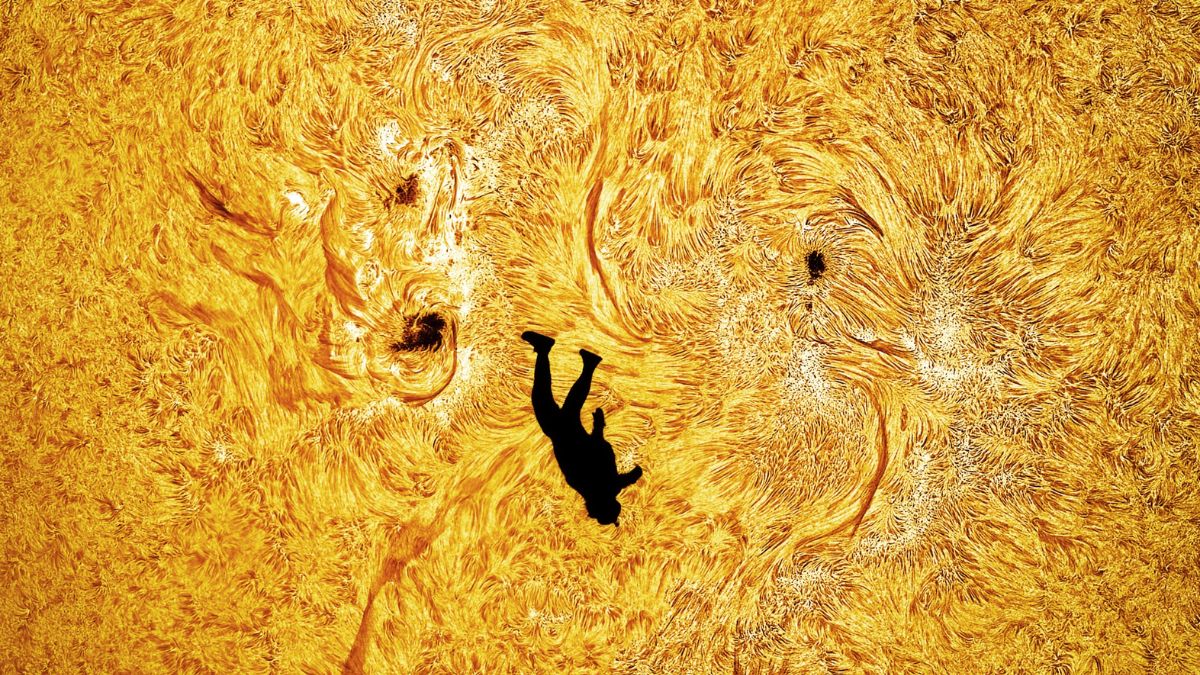It was nearly an impossible shot, but with thorough planning and timely execution, astrophotographer Andrew McCarthy has captured what can be called a ‘once-in-a-lifetime image’ of a man skydiving directly across the face of the Sun .
Titled “The Fall of Icarus”, McCarthy presented a feat never before captured on camera. On November 5, Gabriel C Brown, a YouTuber and McCarthy’s friend, appeared to free-fall in front of the Sun during a carefully planned shot.
We tell you the story behind this astonishing viral image, setting the internet ablaze.
How was this photograph taken?
It is not an editing tickery nor an AI-generated image. The photographer behind this captivating shot has the receipts to prove that it’s very much real.
During the shot, the skydiver was required to jump from a small aircraft at approximately 3,500 feet (1,070 m), whereas McCarthy positioned his telescopes around 8,000 feet (2,440 m) away.
With the use of a specialised solar telescope to capture the Sun in hydrogen-alpha light, the Arizona-based astrophotographer recorded the precise moment of the jump, detailing the texture and the activity on the solar surface.
It wasn’t all done in a day. Weeks went into preparing the timing of the plane, aligning the field of view, meeting strict safety constraints, and coordinating the exact moment of the jump.
McCarthy called it the “most preposterously fake-looking real photo I’ve ever captured,” and “might be the first photo of its kind in existence.”
Taking to his social media handle, the photographer wrote, “Immense planning and technical precision were required for this absolutely preposterous (but real) view: I captured my friend @BlackGryph0n transiting the sun during a skydive.”
Quick Reads
View AllHe even encapsulated the entire process in a behind-the-scenes video, showing how he pulled off the stunning shot.
McCarthy first set up a bunch of telescopes in the Arizona desert while monitoring the live feed. He instructed his friend, YouTuber and skydiver Gabriel Brown, to jump on the radio. McCarthy wrote in the video, “When the time was right, I told him to jump.”
Meanwhile, McCarthy captured a series of photos in an attempt to freeze the motion of his descent. He asserts in the clip, “I got it, dude!”
Reacting to the outcome, the Arizona-based astrophotographer said, “It exceeded my expectations.”
On his Instagram page, Gabriel C Brown, wrote, “We had to find the right location, time, aircraft, and distance for the clearest shot, while factoring in the aircraft’s power-off glideslope for the optimal sun angle and safe exit altitude.”
“And then we had to align the shot using the opposition effect from the aircraft and coordinate the exact moment of the jump on three-way comms!” he added.
There could not have been a better time to photograph the solar surface. The Sun has
entered its most active phase of its 11-year cycle, triggering fierce solar storms. Last week, the strongest solar flare of the year led to radio blackouts across Africa and Europe, according to a report in Futurism.
The solar activity presents a different photo opportunity because of the “abundant” displays of auroras lighting up the night sky.
How the world reacted
People are awestruck, with one social media user calling it “insanely epic.”
Another user heaped praise on McCarthy, saying, “You’re pushing the boundaries of what astrophotography can be.” While another simply wants it to “be the cover of something. Absolutely magnificent.”
People online continue to hail the jaw-dropping work by McCarthy. “I always wonder if you’ll run out of ideas after having done so many amazing photos, and then you do something like this. Bravo,” someone commented.
What do we know about McCarthy’s past work?
Well, this is not the first instance that McCarthy’s photograph has gone viral.
Earlier this year, the astrophotographer captured the International Space Station (ISS) passing in front of the Sun, making it a breathtaking composition. He called it one of his favourite photos as it not only captured the International Space Station in front of the star but also the solar flare.
With inputs from agencies
)